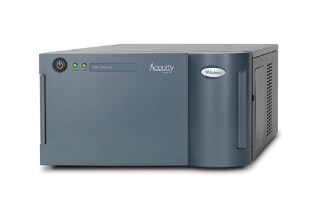ACQUITY UPLC PDA Detector
Quantify high and low level components at once within a single chromatographic separation
Today’s labs are challenged to answer more questions from increasingly diverse and complex samples, which require a wide range of detection techniques. The ACQUITY UPLC Photodiode Array (PDA) Detector offers advanced optical detection, providing unprecedented trace impurity detection and quantitation with spectral analysis capabilities.
It is the ideal detector for any laboratory application, from compound identification to method development. Perfect for routine analyses, the ACQUITY UPLC PDA Detector is reliable, easy to use, and possesses enhanced software control - providing flexibility for simultaneous 2D and 3D operations.
Specifications
|
Wavelength range |
190 to 500 nm |
|
Wavelength accuracy |
±1 nm (via patented1 Erbium filter) |
|
Linearity range |
Deviation at 2.0 AU ≤5%, propylparaben, at 257 nm |
|
Optical resolution |
1.2 nm |
|
Digital resolution |
0.6 nm/pixel to 500 nm |
|
Baseline noise |
±3 μAU, 230 nm, 2 points/s, 2 s, wavelength compensation 310 to 410 nm, 90:10 water/methanol (2D channel with analytical flow cell) |
|
Drift |
≤1.0 x 10–3/AU/hour/°C with analytical flow cell |
|
Sampling rate |
Up to 80 points/s |
|
Light source |
Prealigned, intelligent technology Deuterium lamp |
|
Dispersion volume |
≤0.8 μL (Analytical flow cell); ≤1.5 μL (High sensitivity flow cell) |
|
Flow cell design |
Light-guiding UPLC intelligent technology flow cell |
|
Path length |
10 mm (analytical flow cell) |
|
Flow cell volume |
500 nL (analytical flow cell) |
|
Wetted materials |
316 stainless-steel, fused silica, Teflon AF, PEEK (analytical flow cell) |
|
Pressure limit |
1000 psi (all flow cells) |
|
Flow cell options |
Analytical - 500 nL, 10 mm path length High sensitivity - 2400 nL, 25 mm path length High throughput - 135 nL, 3 mm path length Stainless-steel - 1500 nL, 5 mm path length Titanium - 1500 nL, 5 mm path length Low dispersion analytical - 500 nL, 10 mm path length Low dispersion microbore - 250 nL, 10 mm path length Microscale - 100 nL, 10 mm path length |
|
Physical specifications |
Width: 34.3 cm (13.5 inches) Height: 19.4 cm (7.6 inches) Depth: 60.7 cm (23.9 inches) |
1. US Patent Numbers: 6,423,249 and 6,783,705.
Overview
- High optical and digital resolution, low signal-to-noise ratios, and library matching provides quantitation of trace impurities with low signal-to-noise ratios
- Flexible parameter control for the detection of analytes in any UPLC separation
- Simultaneous 2D and 3D operation in either Empower or MassLynx Software
- Wavelengths of 190 to 500 nm and up to 2.0 AU without compromising linearity
- Low-volume, light-guided flow cell improves light transmission efficiency, allowing quantitation of up to 2.0 AU without compromising linearity
Recommended Use: For superior trace impurity detection and quantification while maintaining maximum chromatographic sensitivity.
Features Header
Get the data you need with wavelength options
The ACQUITY UPLC PDA Detector enables detection and quantification of lower concentrations of sample analytes and comparison of spectra across ultraviolet wavelengths (up to 500 nm). Together with Performance UHPLC/UPLC Systems, the ACQUITY UPLC PDA Detector can fulfill multiple UPLC-MS detection strategy requirements to identify components that are difficult to resolve by conventional HPLC-based methods.
- Offers exceptional signal-to-noise ratios, high optical and digital resolution, and high-sensitivity library matching
- Enables Performance UHPLC/UPLC Systems to map low levels of compounds and determine trace impurity levels within the compound’s peak
- Eliminates the need to compromise optical bandpass and linear range simply to reduce noise
Compound identification with spectral confidence
Small-bore, high-capacity ACQUITY UPLC Columns produce small volume peaks. To avoid band spreading and maintain concentration, the detector flow cell volume must be correspondingly low. To achieve the required volume reduction with conventional absorbance detector flow cells, the path length must be reduced, which results in a loss of sensitivity.
Waters has specifically designed a low volume light-guiding flow cell for the ACQUITY UPLC PDA Detector that has optimum path length and high light throughput. The cell is comprised of Teflon AF, which utilizes total internal reflection principles, to improve light transmission efficiency by eliminating internal absorption.
Detection and resolution optimized without compromise
The ACQUITY UPLC PDA Detector operates at a fixed optical resolution of 1.2 nm, providing high-quality spectral resolution. The low detector noise performance allows you to operate at maximum digital resolution and not sacrifice linearity.
